
Pasta Primavera
Sautéed Vegetables with Spätzle
Spaghettini with Asparagus
Fettuccine with Zucchini
Spaghettini with Fried Eggplant
Pasta Estivi
Mustard Greens with Pignoli
Pasta with Parsley Pesto
Fettuccine with Pesto and Potatoes
Spinach-Mushroom Casserole
Noodles with Cabbage
Vegetable-Noodle Casserole
Pasta with Beans
Avocado Pasta
I’m beginning the section of vegetable dishes with 8 sauces, all based on herbs or vegetables, to be served over pasta. Most of them are just right for ¾ pound of noodles, that is, for 3 or 4 main-course servings. The pesto recipe makes a great deal more than that, but then in the summer, when fresh basil is available, you should get as much as you can for making pesto and freezing for the winter ahead. The Light Tomato Sauce is another one of those resource sauces that are perfectly good served plain, but that can also be turned into a nearly infinite number of variations.
PESTO
I have basil plants growing in pots in the garden behind my house. I chop the fresh leaves onto summer tomatoes, and every so often I harvest a lot of leaves and make pesto. With pesto in the freezer, I can recover the fragrance of summer in my kitchen all winter long. Use it on plain noodles (you’ll need about 1 cup for ½ pound), or to flavor soups, stews, and salad dressings. For an extraordinary treat, combine it with pasta and new potatoes (page 79).
2 cups
4 cups basil leaves
3 cloves garlic
½ cup pignoli
½ cup Italian parsley
1 teaspoon salt
½ to 1 cup oil
½ cup pecorino or Parmesan cheese
Put the basil, garlic, pignoli, parsley, and salt into the food processor or blender with ½ cup oil. Process, adding enough additional oil to make a smooth paste. Add the cheese and process a few seconds longer.
Freezer Pesto: To make pesto for the freezer: Just process the basil, garlic, parsley, salt, and oil. Freeze it in 1-cup portions. When you are ready to use it, defrost the sauce and put it back into the processor with the nuts and cheese. If you want to use it as a seasoning, you can eliminate the nuts and cheese and simply chip off teaspoonfuls of puréed pesto from the frozen mass.
Pesto with Walnuts: Instead of the pignoli, use ½ cup walnuts and omit the cheese.
Pesto with Parsley: Instead of basil, use 3 cups Italian parsley for a fresh midwinter pesto.
LIGHT TOMATO SAUCE
I am reprinting this recipe, which was in The New James Beard, because it forms the basis for a nearly limitless number of variations. It also has the advantage of using canned tomatoes, so that you aren’t dependent on the season or the quality of the tomatoes in your market.
3 cups, enough for about 1 pound pasta
28-ounce can Redpack whole tomatoes in purée
2 small onions, sliced
Salt and freshly ground black pepper to taste
1 teaspoon dried basil (optional)
4 tablespoons butter
Cook the tomatoes, onions, salt, pepper, and basil over medium-high heat for 20 minutes, stirring frequently. If you want a smooth sauce, strain it or purée it in the food processor. I prefer to leave the sauce with lumps, just breaking up the tomatoes with a wooden spoon. Then add the butter and continue to cook until it melts.
Instead of the basil, substitute 1 teaspoon dried oregano or tarragon or any other herb that you fancy.
FRESH TOMATO SAUCE
Enough for 1½ pounds pasta
4 tablespoons unsalted butter
1 medium onion, sliced
2½ pounds tomatoes, peeled, seeded, and chopped (p. 14)
2 teaspoons salt
1 tablespoon fresh basil, or 1 teaspoon dried basil, or ½ teaspoon mixed dried herbs (optional)
Grated cheese
Melt the butter in a heavy saucepan. Add the onion and sauté over medium heat until soft and transparent. Add the tomatoes, salt, and seasoning and simmer gently for 10 minutes. Pour over freshly cooked pasta, mix well, and sprinkle with grated cheese.

3 cups
1 recipe Light Tomato Sauce (p. 67), without the butter
½ pound mushrooms, thinly sliced
4 tablespoons unsalted butter
Cook the tomato sauce. While it simmers, sauté the mushrooms in butter, and add them to the sauce for the final 5 minutes of cooking.
SPINACH-ANCHOVY SAUCE
Try this on spaghettini or angel hair to wake up the appetite at the beginning of a meal.
4 cups, enough for about 1 pound pasta
1 recipe Light Tomato Sauce (p. 67), without the butter
2 tablespoons butter
2 cloves garlic, finely chopped
1 cup chopped cooked spinach
4 anchovies, cut in small pieces
3 tablespoons pignoli, toasted
Cook the tomato sauce. While it simmers, melt the butter and cook the garlic until it is golden brown. Stir in the spinach and anchovies, stir over medium heat for a few minutes, and then add to the tomato sauce.
Toss well, then add the toasted nuts, and serve.
Long-cooked onions have a naturally sweet taste. This is a substantial sauce, and I like to serve it with a pasta that has body, something like bows or wagon wheels or wide ribbons or macaroni.
Enough for ¾ to 1 pound pasta
½ pound unsalted butter
1½ pounds onions, peeled and sliced (about 6 medium onions)
1 tablespoon sugar
¼ cup Madeira
Grated cheese
Melt the butter in a skillet. Add the onions and cook them over medium heat until they are soft and transparent. Stir in the sugar, reduce the heat, and cook very slowly for about 1 hour. Stir in the wine, cook briefly, and pour over a pound of freshly cooked pasta. Sprinkle with grated cheese.
MUSHROOM SAUCE
This makes a nice, quick sauce, even when you use cultivated mushrooms. But if you’re fortunate enough to have some wild mushrooms on hand—morels, chanterelles, cèpes, even field mushrooms—you have a great experience in store for you.
Enough for ½ to ¾ pound pasta
1 pound mushrooms
¼ pound unsalted butter
3 shallots, minced
Salt and freshly ground black pepper
3 tablespoons chopped parsley
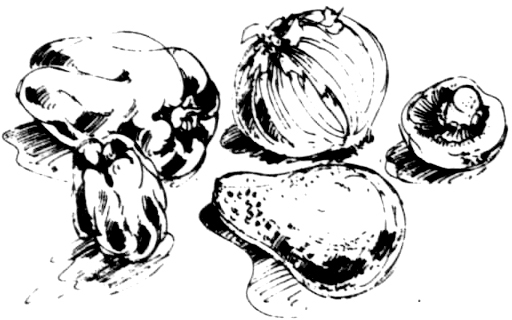
Wipe the mushrooms with a damp cloth and slice them lengthwise, through cap and stem. Melt the butter in a skillet, add the mushrooms and shallots, and sauté them quickly over fairly high heat, tossing them in the pan and seasoning them as they cook with the salt and pepper. Pour over freshly cooked pasta, mix well, and sprinkle with chopped parsley.
HERBED BUTTER SAUCE
I like to make this sauce with tarragon, but if you have a special fondness for some other herb, or if you look on the shelf and there is no tarragon, by all means be flexible. Best of all, of course, is a fresh herb, and I have the idea that more and more cooks are going back to growing their own herb gardens in their kitchen windows or small garden plots.
1 cup, enough for about ½ pound pasta
½ pound unsalted butter
1 shallot, finely chopped
1 teaspoon dried tarragon, or 2 tablespoons fresh tarragon
2 tablespoons chopped parsley
Few drops lemon juice
Melt the butter in a heavy pan, taking care not to let it brown. Skim off the white froth that rises to the top. Add the shallot and tarragon and sauté gently for about 3 minutes. Add the parsley and lemon juice, stir once, and pour the sauce over hot drained pasta.
In Italian, primavera means “spring,” and a primavera sauce should be made with the first, tiny vegetables that pop out in the spring. In the winter, of course, you would use the freshest vegetables you could get at that time, such as broccoli, red peppers, and zucchini, but I’ve suggested a springtime combination that would be just delicious. Just don’t be formal about it. Use what you have in the garden or in the refrigerator. You can even cut up a couple of stalks of celery and add them for the bite.
4 to 6 servings
½ cup fresh peas
½ cup tiny, new beans
½ cup sliced stalks thin asparagus
½ cup sliced mushrooms
4 tablespoons unsalted butter
1 cup light cream, warmed
Lots of freshly ground black pepper
1 pound angel hair, linguine, or even orzo
Grated Parmesan cheese
Lightly cook the peas, beans, asparagus, and mushrooms in the butter until everything is crisply tender. Add the cream and pepper and cook down briefly. Cook the pasta, drain it, and toss with the sauce. Sprinkle with lots of grated Parmesan cheese.
SAUTÉED VEGETABLES WITH SPÄTZLE
You can use any seasonal vegetables in this sauté, as long as you have an eye for color. This is a good winter combination, with one white, one orange, and one green vegetable. It takes a lot of pepper.
4 to 6 servings
1 recipe Spätzle (p. 52)
½ large turnip, in matchsticks
3 carrots, in matchsticks
3 small zucchini, in matchsticks
¼ pound unsalted butter
Salt and lots of freshly ground black pepper
¼ cup chopped parsley
Cook the spätzle. Rinse them under cold water and spread them to dry on a dinner plate. Steam the turnip and carrot strips over boiling water until they are just soft, crisp, and brightly colored. Take them out, plunge them into cold water to stop the cooking, and drain them well. The zucchini do not have to be precooked. All of this preparation can be done several hours before you make the sauté.
When you are ready to cook, melt the butter in a large skillet. Toss the vegetables and spätzle in the hot butter until they are heated through. Do not let them become limp: they should retain their color and stay crisply tender. Season with salt, a great deal of pepper, and the chopped parsley.
You could try this with any fresh vegetable—peas, for instance, or broccoli—and you’d have an exciting meal. Oddly enough, the Worcestershire sauce doesn’t overwhelm the delicate taste of the asparagus. You could use soy sauce, but the Worcestershire gives it a little extra push.
4 to 6 servings
1 pound asparagus, cut in thin diagonal strips
4 tablespoons butter
2 large cloves garlic, finely chopped
2 tablespoons lemon juice
1 tablespoon Worcestershire sauce
1 teaspoon freshly ground black pepper
1 pound spaghettini
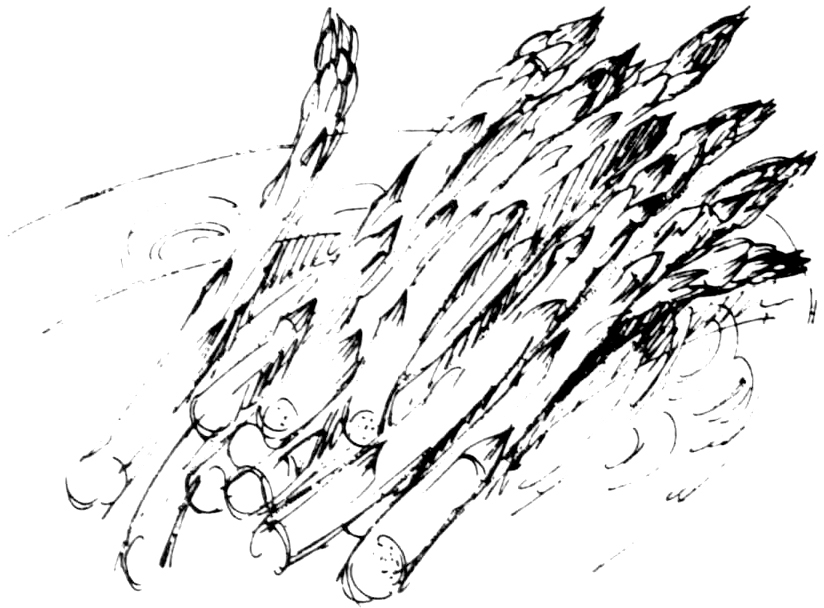
Heat a pot of water. When it is boiling furiously, drop in the asparagus pieces and cook for just 2 minutes. Pour them into a colander and refresh them under cold water.
Melt the butter in a large skillet. Add the asparagus, garlic, lemon juice, Worcestershire sauce, and pepper. Toss everything well for a minute or two. Cook the spaghettini in boiling water. Drain and then combine with the asparagus.
A very pretty dish when it is made with yellow eggy noodles, green zucchini, and red pepper strips, like the Italian flag.
4 to 6 servings
1 pound small, firm zucchini
2 sweet red peppers, peeled
½ cup olive oil
2 onions, chopped
2 cloves garlic, minced
4 tomatoes, peeled, seeded, and chopped, or one 16-ounce can Redpack tomatoes in purée
1 teaspoon salt
⅛ teaspoon dried red peppers, crumbled
1 pound fettuccine
Trim the ends from the zucchini and slice them into julienne strips. Cut the peppers into strips. Heat the olive oil in a skillet, and sauté the onions, garlic, zucchini, and peppers for 5 minutes, stirring occasionally. Add the tomatoes, salt, and dried red peppers, and cook over very low heat for another 5 to 10 minutes.
Cook the fettuccine. Drain and pour the sauce over the hot pasta.
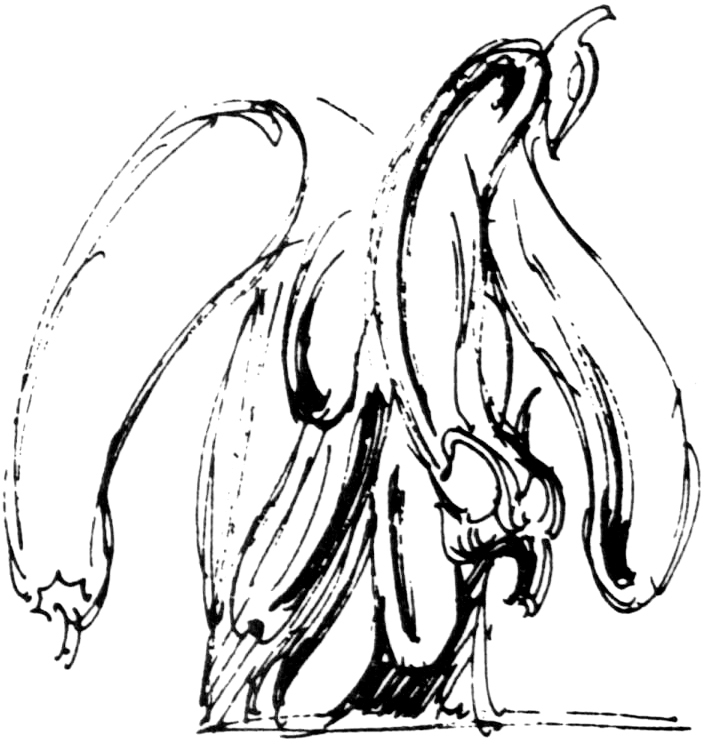
SPAGHETTINI WITH FRIED EGGPLANT
4 to 6 servings
1 medium eggplant
1½ teaspoons salt
Vegetable oil (preferably peanut oil)
½ cup all-purpose flour
1 teaspoon freshly ground black pepper
2 eggs, lightly beaten
2 cups fresh bread crumbs
3 cups Fresh Tomato Sauce (p. 68)
1 pound spaghettini
¾ cup grated Parmesan cheese
Cut the eggplant into ⅛-inch slices. Place in a bowl and sprinkle with 1 teaspoon salt. Weight the eggplant with a plate and a 4-pound weight for 2 to 3 hours, draining off water as it accumulates. Rinse off the salt and dry on paper toweling.
Pour 2 inches of the oil in a deep skillet and heat to 360°. Slice the eggplant across into ½-inch strips. Put the flour and pepper into a plastic bag and add the eggplant slices. Shake well to coat. Remove and dip in egg, then in crumbs, and fry in the hot oil until golden brown. Remove to paper towels.
Heat the tomato sauce. Cook the spaghettini. Drain and pour the sauce over the hot pasta. Serve topped with the fried eggplant and grated cheese.

Some friends brought this recipe back from Italy. Estivi means “summer,” and it makes an elegant summer lunch, especially good on our basil-flavored noodles. Be sure that the noodles are very hot and the sauce icy-cold.
2 to 4 servings
2 large ripe tomatoes, peeled and cut into sixths
1 medium onion, peeled and ringed
4 tablespoons olive oil
1 tablespoon white-wine vinegar
Lots of freshly ground black pepper
½ pound green noodles
2 tablespoons chopped fresh basil, if available
Chopped parsley
Mix the tomatoes, onion, olive oil, and vinegar. Sprinkle with lots of pepper, and let sit for at least an hour, to give the onions a chance to lose their sharpness.
Cook the pasta in boiling water, and drain. Spoon the cold sauce over the hot pasta, and sprinkle with fresh basil and parsley.
VARIATION
Instead of the onion, use 4 sliced scallions.
The pungent flavor of mustard greens requires little extra seasoning, but has an irresistible affinity for oil and garlic.
2 servings
1 large bunch mustard greens, about 2 pounds
¼ cup olive oil
1 fat clove garlic, peeled
½ pound pasta
½ cup pignoli
¼ teaspoon salt
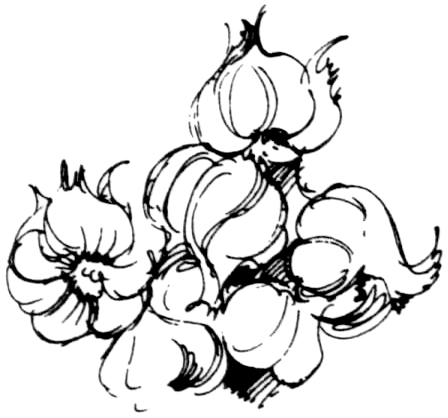
Wash the greens and chop them coarsely. Heat the oil in a skillet with a clove of garlic, taking care that the garlic doesn’t burn. Add the greens, cover the pan, and cook for about 5 minutes, until they are wilted. Shake the pan occasionally to keep them from sticking.
Cook the pasta in boiling water, and drain it. Remove the cover from the greens, add the pignoli, or pine nuts, and remove the garlic clove. Season with salt and pour over the freshly cooked noodles.
PASTA WITH PARSLEY PESTO
4 to 6 servings
4 to 5 bunches parsley, stems removed
3 large cloves garlic
1 cup whole walnuts
1 cup olive oil
1½ teaspoons salt
¾ cup Parmesan cheese
4 tablespoons unsalted butter
¼ cup chopped dill or 1 tablespoon dill weed
1 pound cherry tomatoes
1 pound pasta
2 tablespoons olive oil
Combine the parsley, garlic, walnuts, olive oil, salt, and cheese in the beaker of a food processor. Process the ingredients until you have a well-blended pesto.
Melt the butter in the top of a double boiler over simmering water. Add the chopped dill and the tomatoes. Toss the tomatoes to coat with the dill butter and leave just long enough to heat through.
Cook and then toss the freshly cooked pasta with 2 tablespoons olive oil. Place a portion of the pasta on each plate with some of the pesto on top. Arrange the cherry tomatoes alongside the pasta and spoon some of the dill butter sauce over them. Serve at once.
FETTUCCINE WITH PESTO AND POTATOES
I first had this at a dreary hotel in Genoa that was tolerable only because the kitchen knew how to do a few brilliant dishes. The tiny waxy new potatoes bathed in basil kept me there long after the beds and plumbing should have driven me away. Try this as a very filling first course, to be followed by some grilled fish or chicken and midsummer tomatoes.
4 servings
12 tiny new potatoes; or 6 large new potatoes; or 2 large waxy potatoes, enough to make 1½ cups small potato balls
½ pound fettuccine
1 cup Pesto (p. 66)
¼ cup cream
Grated hard cheese
If you can find really tiny new potatoes, scrub them, leaving the skins on, and boil them until they can be pierced with the point of a knife. If you can’t get the tiny potatoes, use 2-inch new potatoes and cut them in quarters, or peel 1 or 2 large waxy-fleshed potatoes, scoop out balls with a melon baller, and cook them until they are tender.
In a large pot of salted water, cook the fettuccine. Drain it and return it to the pot. Add the hot cooked potatoes, the pesto, cream, and some grated cheese.
SPINACH-MUSHROOM CASSEROLE
I made this one night years ago when I was looking for something to serve with a ham that I had braised in Madeira.
6 to 8 servings
8 ounces wide noodles
¼ pound butter
3 pounds spinach
½ teaspoon salt
½ teaspoon freshly ground black pepper
¼ teaspoon nutmeg
½ pound mushrooms
1 tablespoon olive oil
2 cloves garlic, finely chopped
¼ cup Madeira
½ cup shredded Gruyère cheese
½ cup grated Parmesan cheese
Cook and drain the noodles. Turn them into a bowl and toss with 6 tablespoons of the butter, which has been cut into pieces. Set aside.
Wash the spinach. Remove the heavy stems and put the leaves into a pan with just the water clinging to the leaves. Cover, and steam the spinach over high heat until it is wilted, around 2 minutes. Turn once or twice with a wooden spoon while it cooks. Drain the spinach and chop it coarsely: you should have about 2 cups when you are done. Season with salt, pepper, and nutmeg, and set aside.
Wipe the mushrooms with a damp cloth and slice them lengthwise, through cap and stem. Melt the remaining 2 tablespoons butter with the olive oil in a skillet. Sauté the mushrooms quickly. Add the garlic and cook for 2 minutes. Pour on the Madeira and cook for 1 minute more.
In a buttered casserole, make a layer of the spinach. Sprinkle it with the Gruyère cheese and arrange the mushrooms on top. Make a layer of the noodles, dot with more butter, and sprinkle with the grated Parmesan. Bake in a 350° oven for about 15 minutes, until the casserole is heated through and a chewy golden crust has formed on the top.
NOODLES WITH CABBAGE
I made this up years ago, when I wanted something to serve with sausages and beer. Try it with wide egg noodles or noodle squares or tiny spätzle or nockerli.
6 to 8 servings
One 2-to-3-pound cabbage
5 tablespoons butter or bacon fat
2 tablespoons flour
¾ cup light cream
Salt and freshly ground black pepper
1 pound noodles or dumplings
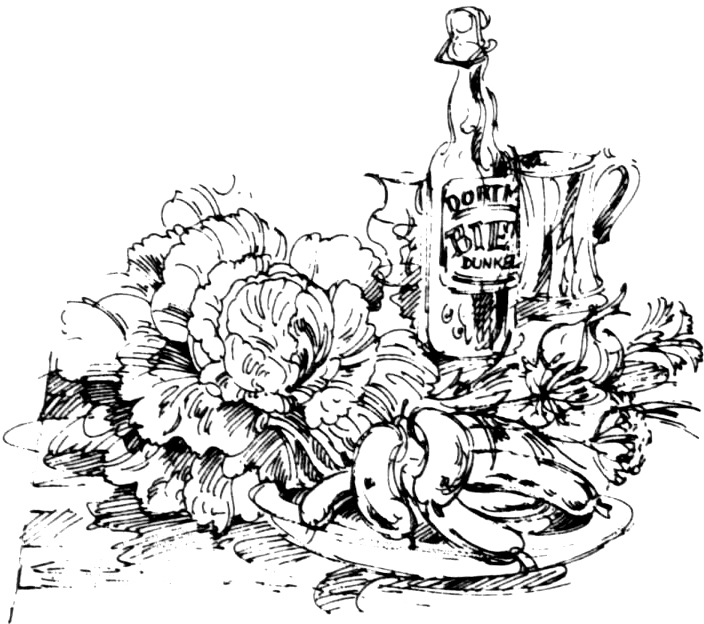
Put the cabbage through the slicing blade of the food processor. Melt the butter or bacon fat in a large skillet and sauté the cabbage until it is lightly browned. Cover and cook for 10 minutes. Sprinkle on the flour and continue to cook, stirring, for a few minutes. Then add the cream, salt, and pepper, and cook, stirring constantly, until the sauce is thickened.
Cook the noodles or dumplings. Drain them, add them to the pot, and let everything bubble together for a few minutes to blend the flavors.
An old-fashioned American dish, despite the tomatoes, zucchini, oregano, and garlic. It was just the thing to take along to a covered-dish supper or to serve to the family for Sunday supper.
6 to 8 servings
4 tablespoons butter
2 tablespoons olive oil
3 onions, sliced
1 clove garlic, chopped
1 cup minced parsley
¼ teaspoon oregano
4 tomatoes, peeled, seeded, and chopped
1 cup chicken broth
Salt and freshly ground black pepper
1 pound wide noodles
3 small, firm zucchini, sliced in rounds
Grated Cheddar or Gruyère cheese
Melt 2 tablespoons of the butter and the oil in a heavy saucepan. Add the onions, garlic, parsley, and oregano, and cook, stirring occasionally, until the onions are golden. Add the tomatoes and chicken broth, salt, and pepper, and cook for 10 minutes.
Cook and drain the noodles. Mix the rest of the butter with the freshly cooked noodles. Stir in the tomato sauce and the zucchini circles and pour the mixture into a buttered baking dish. Sprinkle the top with a handful of grated cheese, dot with more butter, and bake for 15 to 20 minutes at 375°.
This is the heartiest dish imaginable, just the thing for a cold winter night. It’s one of those unrefined peasant dishes that deliver a lot of taste, satisfaction, and protein for relatively little cost. Serve with good bread and a simple strong red wine.
6 to 8 servings
1 pound dry white beans (pea, navy, or Great Northern), or one 16-ounce can white beans
¼ cup olive oil
¼ pound bacon, in 1-inch strips
2 onions, chopped
2 carrots, chopped
1 cup minced parsley
1 teaspoon dried oregano
2 tablespoons dried basil
16-ounce can Redpack tomatoes in purée, or 4 tomatoes, peeled, seeded, and chopped
½ cup bean liquid
2 teaspoons salt
1 teaspoon freshly ground black pepper
1 pound elbow macaroni
4 tablespoons butter, at room temperature
½ cup grated sharp cheese
Chopped parsley
If you use dried beans, cover them with cold water, bring to a boil, cook 2 minutes, and then remove from the heat and let stand, covered, for 1 hour. Continue cooking the beans over medium heat till they are just tender. Drain. Reserve some of the liquid for the sauce. If you use canned beans, merely drain them and set them aside, reserving ½ cup of the liquid.
Heat the olive oil in a heavy casserole and sauté the bacon strips until they are half cooked. Add the onions, carrots, parsley, oregano, and basil, and cook until the vegetables are wilted. Add the tomatoes, bean liquid, salt, and pepper. Cover and simmer for about 10 minutes, until the vegetables are tender. Add the drained cooked beans and simmer for another 20 minutes.
Meanwhile cook and drain the macaroni. Toss with bits of the butter and grated cheese, and then mix with the bean sauce and a little of the bean liquid. Serve in heated bowls, and sprinkle more cheese and chopped parsley on the top.
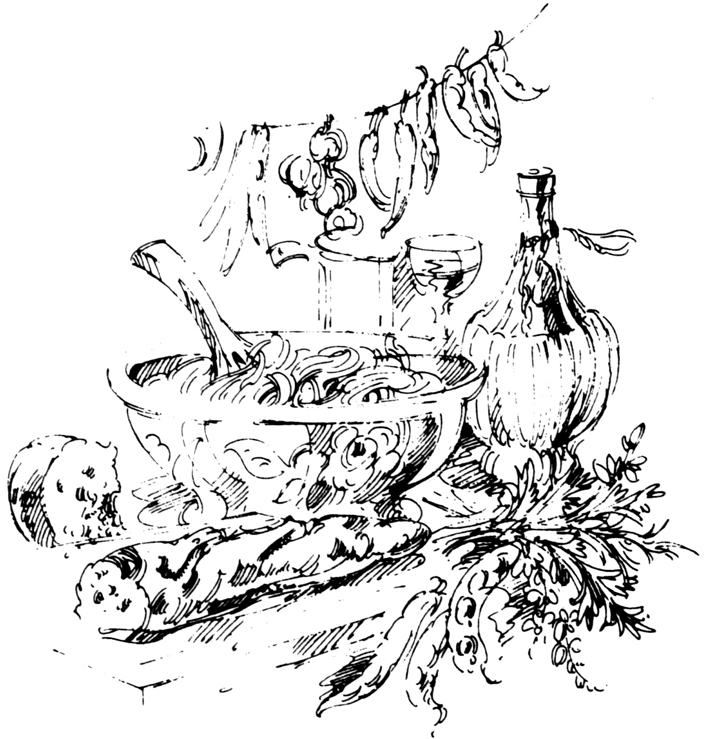
AVOCADO PASTA
This is a superb dish, but it’s a bit tricky to handle because of the softness of the dough. You could make only the avocado sauce, and use commercial spinach pasta for the color, but it wouldn’t have the delicate sensuous flavor of the real thing.
6 to 8 servings
¼ teaspoon salt
3 very ripe avocados
3 eggs
2 tablespoons butter
1 clove garlic, minced
½ teaspoon salt
½ teaspoon freshly ground black pepper
2 cups heavy cream
3 tablespoons grated Parmesan cheese
Pimiento
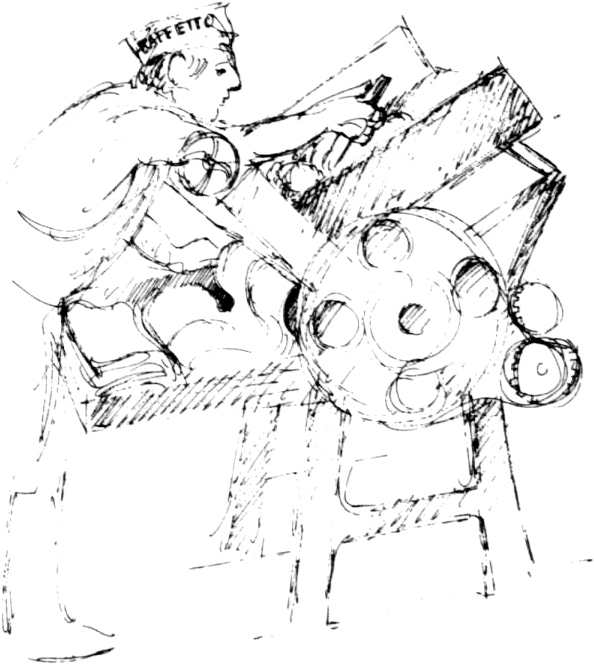
To make the pasta: Put the flour and ¼ teaspoon salt in a large mixing bowl. In another bowl, mash one of the avocados, which you have first peeled and cut into chunks. Stir in the eggs with a wooden spoon. Add the avocado mixture to the flour and blend thoroughly in the bowl or in the food processor.
Turn out the dough onto a floured board and knead it by hand for 5 minutes. The avocado will have made it very soft, so that you will have to sprinkle it frequently with more flour. Roll it into very thin sheets, using the machine. Cut the sheets into 1½-inch squares. Lay them on a cookie sheet or a piece of foil and chill them in the freezer for about a half hour, until they are firm.
Bring a large pot of salted water to the boil. When the dough squares are firm, take them out of the freezer, drop them into the boiling water, and cook for about 3 minutes, until they are properly done. Drain. Return the noodles to the pot, and add the butter, garlic, salt, pepper, heavy cream, and the remaining 2 avocados, peeled and cubed. Sprinkle with Parmesan cheese and stir gently over medium heat so that everything is coated. Transfer to a serving dish, sprinkle with more cheese, and serve at once, garnished with slivers of red pimiento.